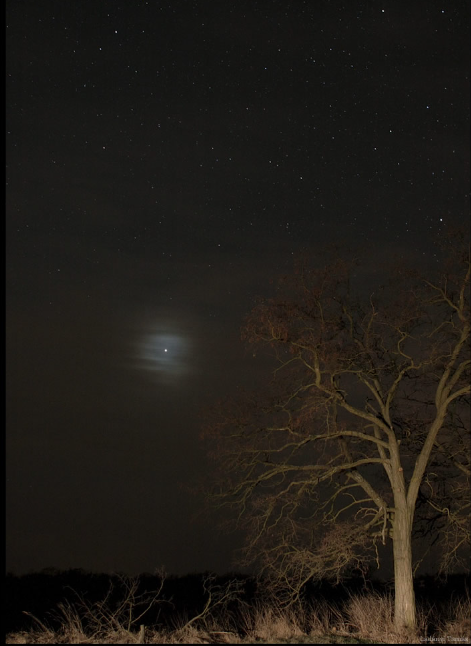Venus, Coronae & Aureoles
Venus, Coronae & Aureoles: An Illuminating Atmospheric Phenomenon
Have you ever gazed at the evening sky and noticed a radiant glow surrounding Venus? This captivating spectacle is known as a corona or aureole. It occurs when particles in the atmosphere, such as water droplets, dust, pollen, smoke, aerosols, and even tiny insects, scatter sunlight. These particles, whether transparent or opaque, deviate the incoming rays in the forward direction, creating an intense glow near the sun.
While coronae and aureoles exist around not only Venus but also the moon, planets, and stars, they are typically too faint to be seen with the naked eye. Fortunately, advancements in photography allow us to capture these mesmerizing phenomena. However, due to Venus' relative faintness, capturing the full extent of its aureole can be challenging.
The size of an aureole in photographs is influenced by two factors: the duration of the exposure and the size of the scattering particles. Longer exposures reveal larger aureoles, while smaller particles yield more prominent effects. For instance, minuscule particles of stratospheric dust lifted by volcanic eruptions can produce immense aureoles like the Bishop's Ring.
Aureoles generally appear white or the color of the source light. Their intensity gradually diminishes as you move away from the source. The particles responsible for their formation have a range of sizes. However, when the size range of these particles decreases, the glow begins to exhibit structure and color.
As the particle size range narrows, a red edge emerges because aureoles from long-wavelength red light are larger than those from blue light. A further reduction in particle size results in a faint ring beyond the red edge of the central aureole. This ring exhibits a blue or violet hue on its inner side and red on its outer side. Continued narrowing of the particle size distribution can give rise to second or even multiple rings, forming what is known as a corona.
The appearance of a definite red boundary to the central glow or the visibility of the first ring are often used as criteria to distinguish between an aureole and a corona. However, the exact definition can be debated. Instead of getting caught up in technicalities, why not appreciate the beauty of these atmospheric phenomena in all their forms?
In conclusion, Venus, coronae, and aureoles provide a fascinating glimpse into the interplay between sunlight and atmospheric particles. These optical wonders showcase the intricate nature of light scattering and particle size distribution. So, the next time you find yourself gazing at the evening sky, take a moment to admire the celestial ballet unfolding before your eyes.

Corona/Aureole around Venus - imaged February 21, '09 at Veszprém, Hungary by Tamás Ladányi (site, TWAN). ©Tamás Ladányi, shown with permission.

This is the largest aureole/corona around Venus that Tamás has yet photographed, about 5� diameter (other Venus effects 1,2,3). Venus remains dazzling in evening skies and we may see more.
Corona or aureole?
Particles in the atmosphere, water droplets, pollen, dust, smoke, aerosol, the air itself and even small insects - regardless whether the particles are transparent or opaque - scatter the sun's rays. Mostly they do so most strongly with only small deviations from the incoming rays - the forward direction. The result is an intense glow near to the sun called an aureole. They exist around the moon, planets and stars but are usually too faint to be seen.
The size of an aureole in photographs is determined to some extent by the duration of the exposure. Venus is so relatively faint that to see the full extent is difficult. But the other factor is the size of the scattering particles. Small particles give large aureoles, for example, the very small particles of stratospheric dust lofted by volcanic eruptions produce the immense Bishop's Ring.
Aureoles are white or the colour of the source light. They decrease smoothly in intensity away from the source. Their originating particles have a range of sizes.
When the particle size range decreases the glow starts to take on structure and colour. First of all a red edge appears because aureoles from long wavelength red light are larger than those from blue. A further decrease in the particle size range leads to a faint ring beyond the red edge of the central aureole. the ring is blue/violet inside and red outside. Further narrowing of the size distribution produces a second or even more rings. That is corona.
The IRIS Lorentz-Mie simulations at lower left show the effects of changing size distribution for spherical particles. (The variation quoted is the standard deviation of a Gaussian size distribution expressed as a percentage of the mean.)
When exactly can an aureole be called a corona? That is debatable. When we can see a definite red boundary to the central glow is a good start, others might say when the first ring is visible. But why be pedantic! Admire them all.
Note: this article has been automatically converted from the old site and may not appear as intended. You can find the original article here.
Reference Atmospheric Optics
If you use any of the definitions, information, or data presented on Atmospheric Optics, please copy the link or reference below to properly credit us as the reference source. Thank you!
-
<a href="https://atoptics.co.uk/blog/venus-coronae-aureoles/">Venus, Coronae & Aureoles</a>
-
"Venus, Coronae & Aureoles". Atmospheric Optics. Accessed on December 22, 2024. https://atoptics.co.uk/blog/venus-coronae-aureoles/.
-
"Venus, Coronae & Aureoles". Atmospheric Optics, https://atoptics.co.uk/blog/venus-coronae-aureoles/. Accessed 22 December, 2024
-
Venus, Coronae & Aureoles. Atmospheric Optics. Retrieved from https://atoptics.co.uk/blog/venus-coronae-aureoles/.